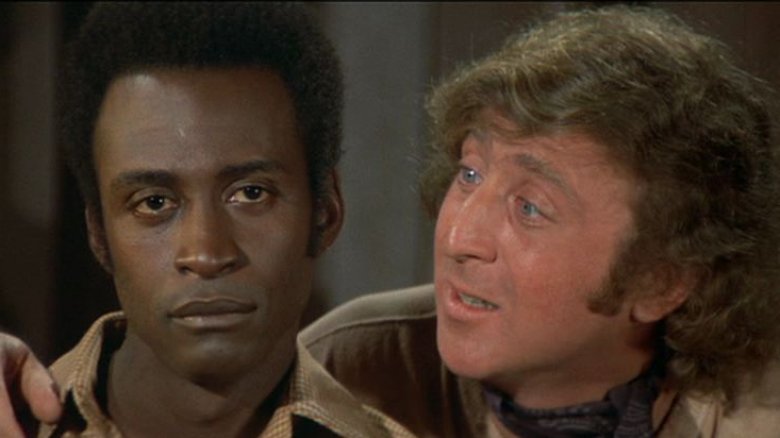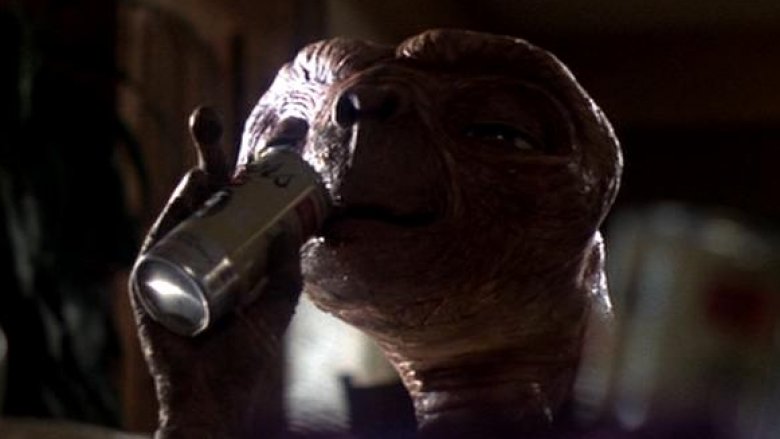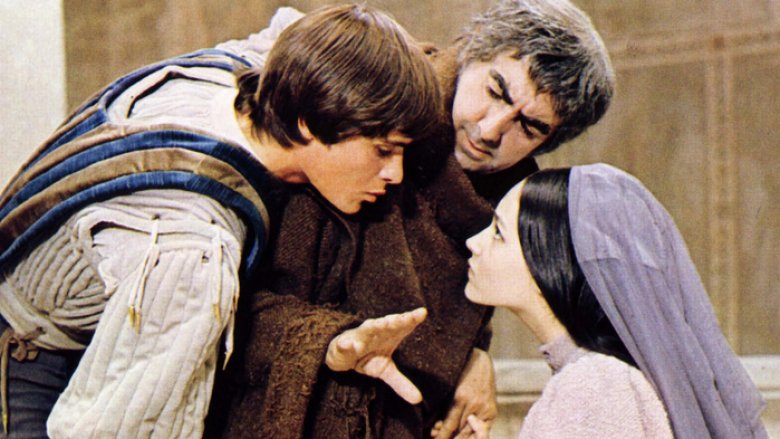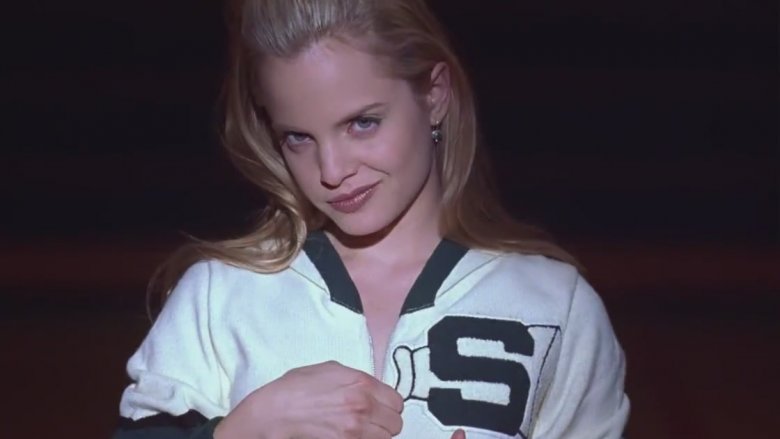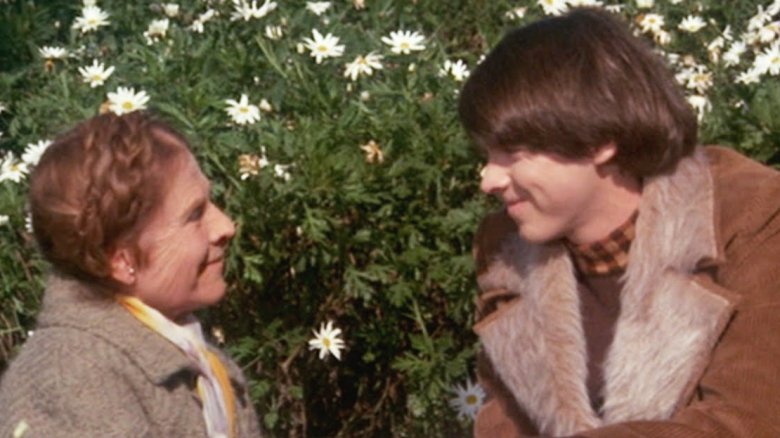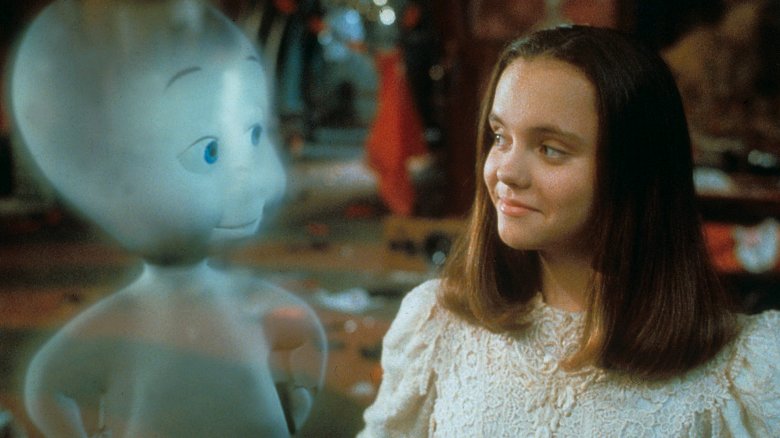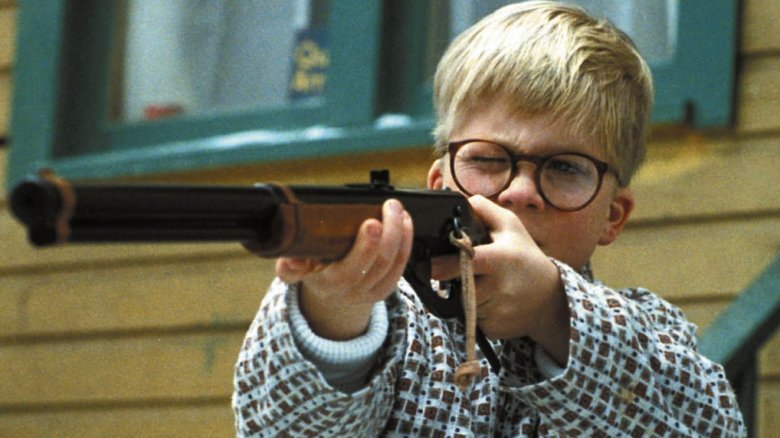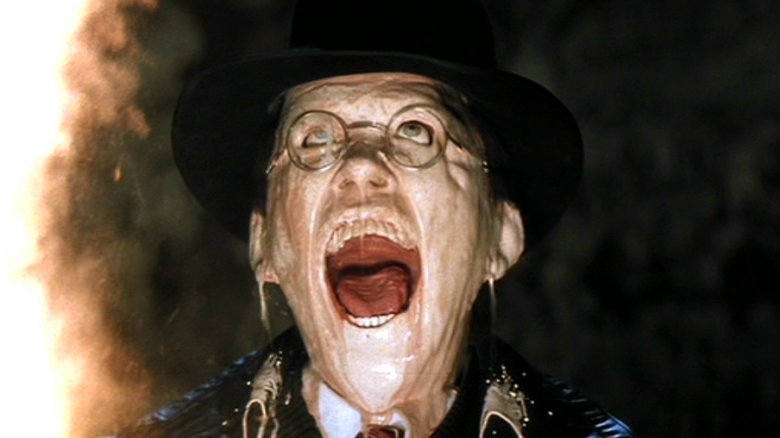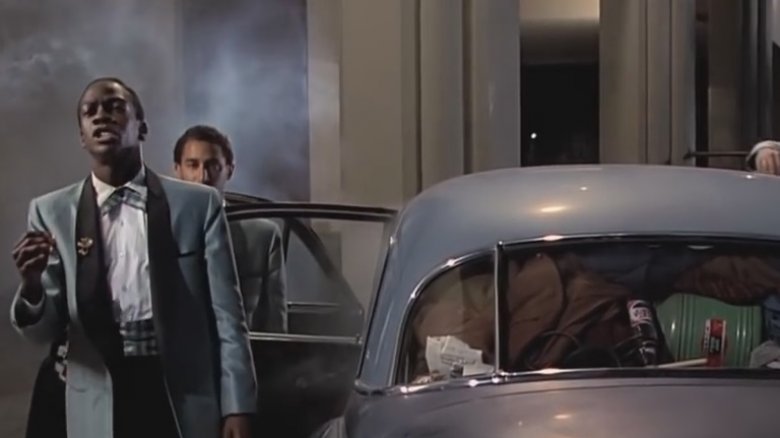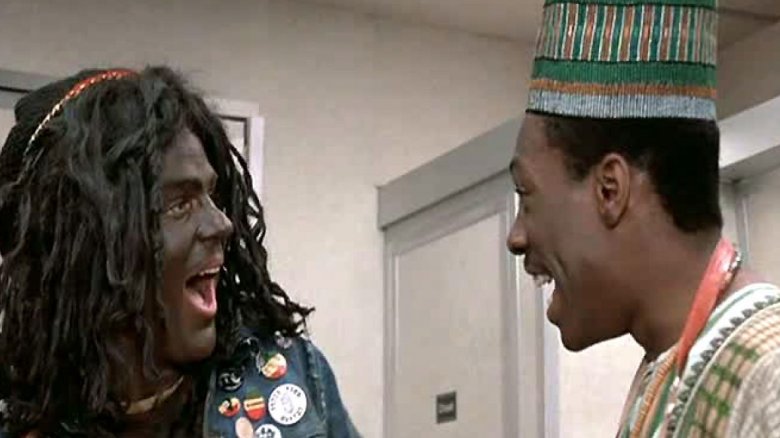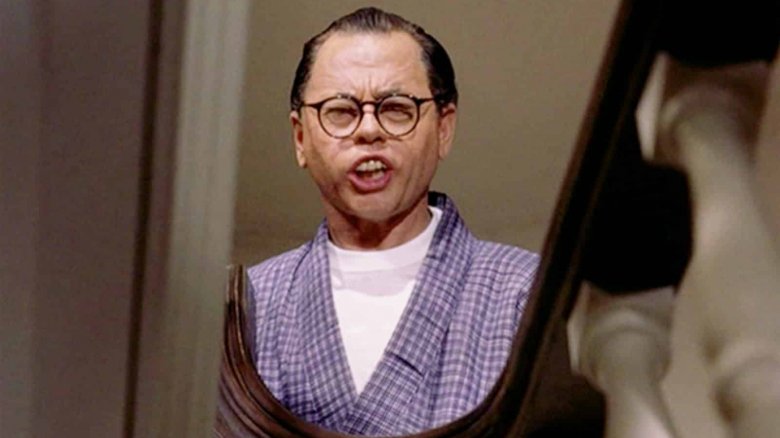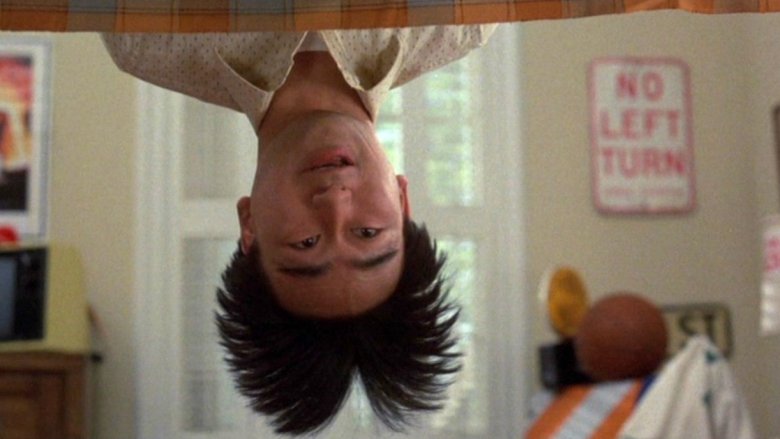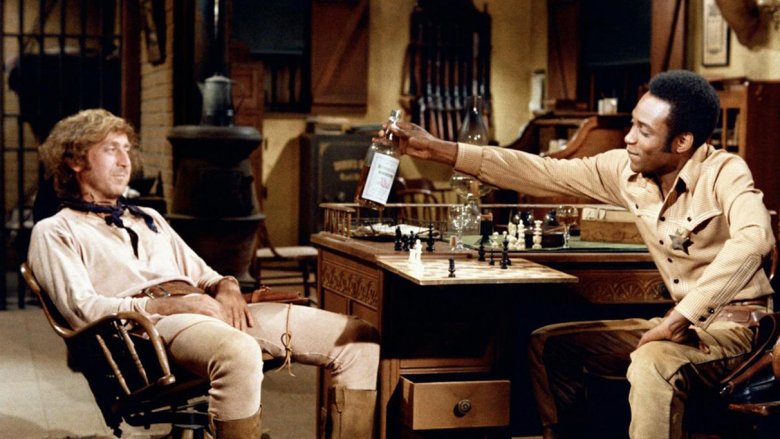Movie Scenes That Would Not Be OK To Film Today
In this modern era, it's easy to assume that anything goes in cinema. And in many ways, we've come far since the censorship laws of the past. However, there are certain scenes from bygone films that leave us feeling uneasy. Indeed, just last year, many parents took umbrage with a scene in the new Peter Rabbit film, wherein Peter and his friends use Mr. McGregor's blackberry allergy to their advantage, pointing out that food allergy bullying is a very real threat to a lot of children. These angry guardians went so far as to start the hashtag #boycottpeterrabbit, proving that even seemingly innocuous scenes are ripe for discussion and debate. The rapid-fire communication of the internet has made it easier than ever to express distaste or discomfort and share it among hundreds, thousands, or even millions of people. With that in mind, here's a look back at some movie scenes that may have seemed like a good idea at the time, but which would likely find themselves the subject of their very own hashtag if filmed today.
Alien inebriation in E.T. (1982)
When ten-year-old Elliot discovers an alien in his shed and lures it into his home with Reese's Pieces, how is he to know that the two are destined to form one of the greatest human-alien friendships in all of cinematic history? Their bond is so strong, in fact, that it manifests in a psychic connection, causing Elliot to experience a drunken escapade in the middle of school. The appearance of substances like beer and cigarettes was not uncommon in movies from the '80s, but it is something many of us — especially those of us who had to go through the D.A.R.E. program in school — find off-putting in movies aimed at children and families. E.T. takes it a step further by displaying a minor in a state of inebriation. Even though it's the alien who is imbibing the brew, little Elliot seems to be experiencing the age-inappropriate side effects.
Underage nudity in Romeo & Juliet (1968)
While on the subject of minors engaging in age-inappropriate activity, it would be remiss not to mention Franco Zeffirelli's gorgeous 1968 adaptation of Shakespeare's Romeo & Juliet. One of this film's great triumphs is in its casting of the titular characters as teenagers, the way they are portrayed in the original play. This casting choice really knocks home the idea that the two star-crossed lovers are truly rebellious, rash kids making a slew of inadvisable choices to get back at their feuding parents. Unfortunately, it also involves putting real-life minors in the buff in front of audiences all over the world. While Leonard Whiting and Olivia Hussey perform their roles with great maturity, it's uncomfortable for the viewer to realize that they're gazing upon distinctly sexualized teens. It's indisputable that this film is a great contribution to the world of cinema, but today it would also be a ripe contender for a lawsuit.
Teen toplessness in American Beauty (1999)
Another candidate for the underage nudity lawsuit goes to the disturbing drama American Beauty, wherein Kevin Spacey plays Lester Burnham, an unfulfilled advertising exec caught in an unhappy marriage. In his frustration, he becomes obsessed with his teenage daughter's friend Angela, played by Mena Suvari. That a middle-aged man is having sexual fantasies about a teenage girl is disturbing enough, but the film takes it one step further by involving these two characters in a sexual encounter. Certainly off-putting, but Suvari was of age at the time. Her co-star Thora Birch, however, in her role as Spacey's daughter Jane Burnham, was not of age when she flashed her bare breasts at the neighbors in one memorable scene. The pedophilia, underage areolae, and Spacey's current scandal-ridden standing all combine into a perfect cocktail modern audiences would not find acceptable today.
The uncomfortable sex scene in Harold and Maude (1971)
Teens aren't just caught in bed with each other or with other people's dads in the depraved annals of cinematic history. Sometimes they're discovered with their geriatric girlfriend, as is the case in the 1971 cult classic Harold and Maude. Harold is 18 years old and obsessed with death to the point that he is constantly faking suicide. He meets Maude, closing in on her 80th birthday, who is so vivacious and fun-loving that she puts his youth to shame. They form a quirky friendship that would have been novel and enjoyable enough, but the film opts to go the extra mile and hook this odd couple up in the romantic — and sexual — sense. Now, Harold is technically an adult, but still the understanding that Maude could be his grandmother means the audience is being asked to be perhaps excessively open-minded when the couple decides to consummate their romance.
"Can I keep you?" -- Voyeurism in Casper (1995)
Another atypical friendship-turned-romance comes in the 1995 adaption of the Harvey Comics property Casper. Our titular boy ghost is lonely and desperately seeks a human companion. His three raucous poltergeist uncles are very intent, however, on preventing anyone from living in their home for too long. But when Dr. Harvey and his daughter Kat move in, Casper decides to try to make a good impression. Before befriending Kat, he observes, with no little excitement, that she is sitting on his bed. After startling her quite thoroughly, the living girl and the undead boy do grow close, but it seems that little Casper wishes for more. Toward the end of the film, he's briefly granted a living body. Dancing with Kat among other teens from the town, he whispers into her ear, "Can I keep you?" While obviously intended to be romantic, that line now feels like a creepy, possessive thing for a boy to say to a girl, especially when impressionable ears are taking it in.
Ralphie receiving a BB gun in A Christmas Story (1983)
Plenty of parents don't want their children playing with guns. Such is the case with Ralphie's folks in the oft-lauded holiday classic A Christmas Story. But all Ralphie wants for Christmas is a Red Ryder BB gun, and begs his parents to resounding exclamations of "You'll shoot your eye out!" While the story is really more focused on the trials and tribulations of growing up in middle America and Ralphie's single-minded pursuit of his material desire, it's the satisfaction of seeing Ralphie obtain his coveted weapon that many viewers hold dear. But in a post-Columbine (and Sandy Hook, and Parkland, etc.) era, it is especially upsetting to think of children and guns together in any context, even guns that merely shoot BB pellets. Parents of today who are constantly in fear for their children's safety at school would surely have some words for Ralphie's irresponsible-seeming parents.
Nazi face-melting in Raiders of the Lost Ark (1981)
It's hard not to love Harrison Ford's reckless, daring feats of acrobatics and endurance as Indiana Jones. And while his archaeological caution leaves something to be desired, he's a master at saving the day and looking cool while doing it. His first appearance in Raiders of the Lost Ark had him up against that well-worn American enemy, the Nazis, who are seeking the Ark of the Covenant in an attempt to make their armies invincible. Toward the end of the film when the Ark is opened, Indy and his companion Marion sensibly look away, but the Nazis who can't tear their eyes from the spirits exiting the holy vessel are unceremoniously melted where they stand. While any sensible modern audience would see no problem with Nazis getting their comeuppance, gruesome face-melting in a PG-rated film would rile up today's discerning viewer.
Racially-charged reefer madness in Back To the Future (1985)
For a film that spends a great deal of time in the politically incorrect 1950s, Back to the Future actually does a great job of staying cool and relevant decades after its initial release. However, there's one minuscule moment, barely memorable, that gives the modern viewer pause. Marty McFly has possibly altered his parents' timeline so badly that he has to somehow ensure that they get together at the school dance. In a mix-up with bullies, he gets shoved into the trunk of the car belonging to Marvin Berry and the Starlights, the all-black band hired to play for the dance. The band members exit the car and threaten the bullies amid clouds of marijuana smoke. This seems innocuous enough, but now that marijuana is legal or decriminalized in most of the United States, and since many black men are still serving out unfair sentences for pot possession, it taints an otherwise thoroughly enjoyable sci-fi romp with a gross stereotype.
Dan Aykroyd's unflattering blackface performance in Trading Places (1983)
It goes without saying that blackface performance is definitely not okay. Born out of mockery of the plight of African slaves and kindled in the era of Jim Crow, it's a disgusting reminder of how thoughtless and cruel white Americans have been in their dealings with black Americans. And yet, it has a storied history in entertainment, even up into the '80s and '90s. Beloved comedian Dan Aykroyd is one of the many who've donned tasteless blackface in cinema, doing so during a brief scene in Trading Places, a comedy in which he stars opposite Eddie Murphy in a Prince and the Pauper-inspired tale. While the film certainly intends to bring up the idea of inequality between races and succeeds in many ways, the modern viewer has to ask themselves if it could have been done without having to resort to the cheap racist comedy of yesteryear.
The stereotypical portrayal of a Japanese neighbor in Breakfast At Tiffany's (1961)
Certainly one of the most stylish and recognizable films of the 20th century, Breakfast At Tiffany's, adapted from Truman Capote's beloved novella, certainly has a couple concerning moments in retrospect. Chief among them is Mickey Rooney's unflattering yellowface performance as Mr. Yunioshi, Holly Golightly's angry Japanese landlord and neighbor. While it's true that white actors are cast in parts often intended for Asian or Asian-American actors even to this day, it's Rooney's disrespectful portrayal of Yunioshi that sets the modern viewer's teeth on edge. His overzealous "Go-right-ree" when referring to Audrey Hepburn's carefree ingenue, paired with his comically large buck teeth, triple-thick spectacles, "traditional" Japanese robes, and propensity for engaging in what appears to be a tea ceremony (something not generally undertaken by your average Japanese citizen), would absolutely not be acceptable today. Luckily, his part in the film is minor, leaving us to enjoy Hepburn's manic debutante antics.
Any scene involving Long Duk Dong in Sixteen Candles (1984)
Even when Asian-American actors are cast in the roles intended for them, the roles themselves can be deeply offensive. Japanese-American actor Gedde Watanabe got his first big break in the U.S. as the Chinese foreign exchange student Long Duk Dong in the John Hughes comedy hit Sixteen Candles. But every time Dong appears on screen, a gong sounds — and that's just the tip of the racist iceberg. Dong is the only character of color, ostensibly in the film solely for the comic relief he provides as the oft-manic, heavily-accented, big-girl-loving, misunderstanding-inspiring Amerophile. While there are plenty of eyebrow-raising aspects of this film — underage drinking and smoking, questionable romantic and sexual choices — it's the unfortunate addition of these outdated stereotypes that puts a damper on a regular rewatch.
Basically all of Blazing Saddles (1974)
Mel Brooks' Blazing Saddles is a masterpiece of satire, and under absolutely no circumstances would it fly if it had been made today. The word "irreverent" was made for this clever, no-holds-barred takedown of racism made in the aftermath of the civil rights movement. From the brazen callout of naming a character Hedley Lamarr to the frequent use of racial slurs, Saddles is successful because it makes audiences uncomfortable. To highlight the absurdity of racism and uplift a black hero, Brooks pushed the envelope as far as he thought he could, to great success. But despite that success, it's safe to assume that modern audiences would take issue with a white director using such racially charged language and imagery in such an obvious, uncouth, and unapologetic manner. Besides, there are too many old Hollywood jokes that would go over everyone's head.
